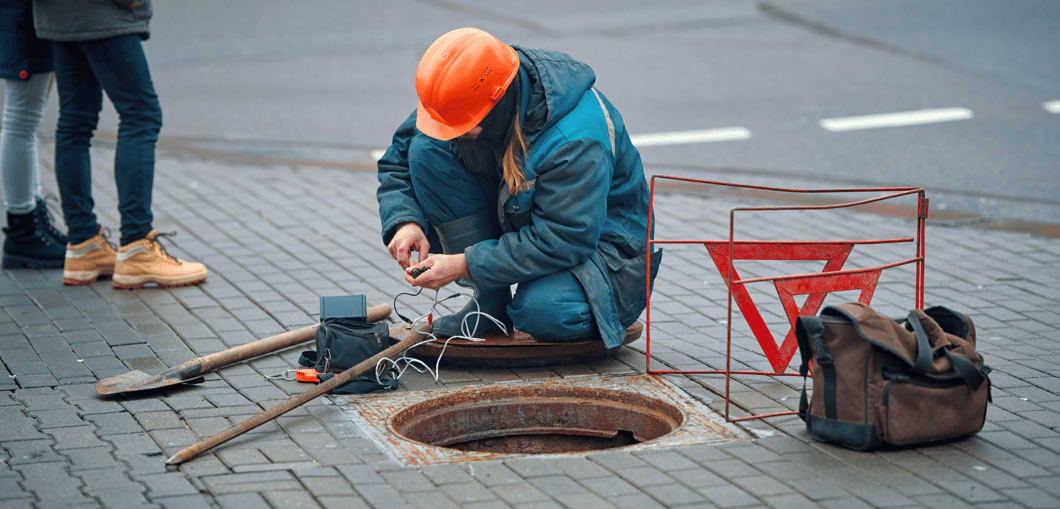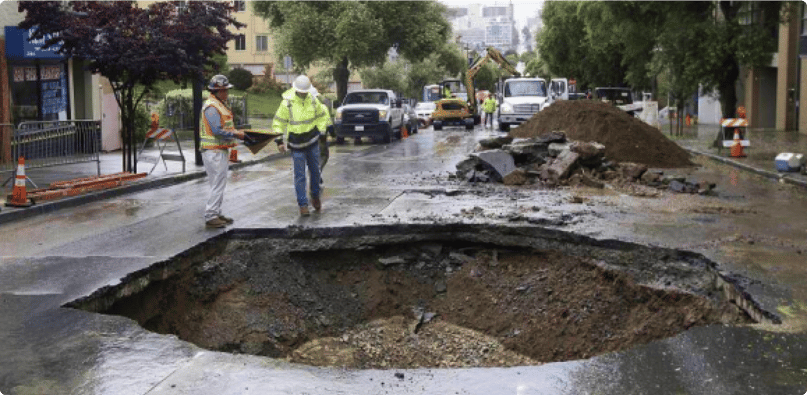How Frontline Sewer Workers Can Stay Safe On The Job
It's dangerous to work in the field—full stop.
You can limit the chances of an accident at work by understanding what threats can arise when you're in the field, having a strategy to minimize risk, and making plans for what to do when they do.
In this article, we'll explore some of the serious threats survey crews face and discuss practical strategies for fostering a safer working environment.

Traffic and Pedestrian Safety
Working around busy streets in urban areas in close proximity to the public is part of the job, but when non-crew members are around, there are a lot more variables that you need to account for.
- Pedestrians: It's a rule of nature, an open manhole attracts curious pedestrians (see: lookie-loos and rubberneckers), increasing the risk of accidents. Even in closed-off work areas, it's not uncommon to turn around and see someone trying to look over your shoulder. When pedestrians get a little too close for comfort, we've found the best strategy is to be polite but firm. Let them know that you're working in a closed-off area, it's dangerous, and they need to move along.
- Bicyclists: Cyclists don't always believe the rules apply to them. Where cars and pedestrians see a closed-off road, cyclists see an opening between signs that they can shoot between. To avoid cyclists zipping through your workspace, decrease the gaps between your road signage. If you need to leave the sidewalk open, consider placing traffic cones down in a way that doesn't obstruct walkers but makes it so folks on bikes need to slow down or dismount.
- Motor Vehicles: Vehicles represent the most significant danger to you and your crew. Make sure your signage is visible and so are you via high-viz clothing. Also, make sure your hearing isn't obstructed (hello, earbuds and headphones) so you can listen for oncoming traffic.
- Animals: Humans aren't the only ones that can be interested in a jobsite. Some of our frontline worker contacts have reported dealing with dogs, snakes, and even a bear while in the field.

Tips for Dealing with Physical Hazards and Environmental Threats
When you’re working in the field, finding ways to limit hazards is crucial.
- Verbalize potential hazards: See something, say something is a rule on many dangerous jobsites around the world. It's a simple practice that can make a huge difference. Make it a habit to verbalize potential hazards around the job site as you notice them. Loose cord? Let everyone know. Opening a maintenance hole? Give your team a shout.
- Mitigate exposure to H2S: Hydrogen sulfide (H2S) is a toxic gas commonly found in sewer environments. Use gas monitors and adhere to safety protocols to avoid exposure to dangerous levels of H2S. Be aware that dangerous levels of H2S can be found directly outside utility holes, so exercise caution even when working at ground level.
- Understand how to wear PPE properly: You need to know when and where to use different types of personal protective equipment (PPE), such as gloves, hard hats, boots, goggles, and high-visibility clothing. Beyond knowing how to wear PPE, you need to know how to maintain your gear and when it's time to retire it. Make sure you're checking for wear and tear, ensuring everything fits properly, and replacing gear when necessary.
- Stay hydrated and bring snacks: Rushed decision-making happens when you're hungry, and it's easy to become dehydrated on warm days, even if your physical activity is limited. Also, let's be real: you're nicer to your crew when you've had a snack. Check the weather before you head out to ensure you’re packing enough water and snacks. If you have a hard time remembering how much water you’ve drank, invest in a reusable water bottle with measurement marks.
- Ask questions: There is no shame in getting clarification or asking a question to ensure you and your team are on the same page. As one of our friends in the field says, “The only dumb question is the one not asked.”

Emergency Preparedness and Response
Murphy's General Laws:
- Nothing is as easy as it looks.
- Everything takes longer than you think.
- Anything that can go wrong will go wrong.
- If there is a possibility of several things going wrong, the one that will cause the most damage will be the one to go wrong.
- If anything simply cannot go wrong, it will anyway.
Basically, even when you've accounted for every variable, sh$*%t can hit the fan. When circumstances don't go according to plan, you need to stay calm and assess the situation. Take a breath and ask yourself what's happening. What is the threat level? and what protocol is in place? Make sure you are trained to respond effectively to emergencies, such as pipe bursts or blockages, or injuries to yourself, your crew, or the general public, to minimize risks to safety and infrastructure integrity.
Final Thoughts
In high-pressure situations, such as emergencies or tight deadlines, safety should always be the top priority. You need to resist the temptation to cut corners and prioritize adherence to safety protocols. They are there for a reason.
Stay safe out there.
If you have any safety tips we missed, we’d love to hear them!
